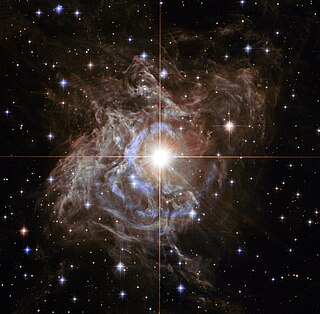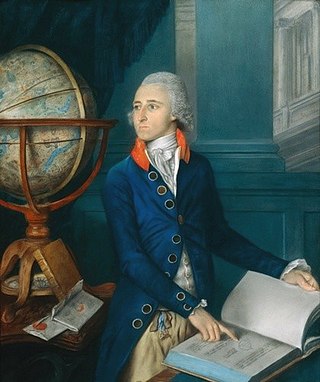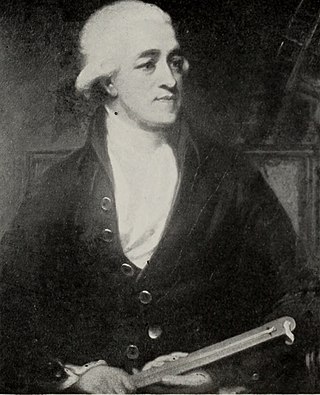Related Research Articles

Algol, designated Beta Persei, known colloquially as the Demon Star, is a bright multiple star in the constellation of Perseus and one of the first non-nova variable stars to be discovered.

Frederick William Herschel was a German-British astronomer and composer. He frequently collaborated with his younger sister and fellow astronomer Caroline Herschel. Born in the Electorate of Hanover, William Herschel followed his father into the military band of Hanover, before emigrating to Britain in 1757 at the age of nineteen.

Sir John Frederick William Herschel, 1st Baronet was an English polymath active as a mathematician, astronomer, chemist, inventor and experimental photographer who invented the blueprint and did botanical work.
Timeline of stellar astronomy

A Cepheid variable is a type of variable star that pulsates radially, varying in both diameter and temperature. It changes in brightness, with a well-defined stable period and amplitude. Cepheids are important cosmic benchmarks for scaling galactic and extragalactic distances; a strong direct relationship exists between a Cepheid variable's luminosity and its pulsation period.

Sir George Biddell Airy was an English mathematician and astronomer, as well as the Lucasian Professor of Mathematics from 1826 to 1828 and the seventh Astronomer Royal from 1835 to 1881. His many achievements include work on planetary orbits, measuring the mean density of the Earth, a method of solution of two-dimensional problems in solid mechanics and, in his role as Astronomer Royal, establishing Greenwich as the location of the prime meridian.

Aquila is a constellation on the celestial equator. Its name is Latin for 'eagle' and it represents the bird that carried Zeus/Jupiter's thunderbolts in Greek-Roman mythology.

Messier 5 or M5 is a globular cluster in the constellation Serpens. It was discovered by Gottfried Kirch in 1702.
John Michell was an English natural philosopher and clergyman who provided pioneering insights into a wide range of scientific fields including astronomy, geology, optics, and gravitation. Considered "one of the greatest unsung scientists of all time", he is the first person known to have proposed the existence of stellar bodies comparable to black holes, and the first to have suggested that earthquakes travelled in (seismic) waves. Recognizing that double stars were a product of mutual gravitation, he was the first to apply statistics to the study of the cosmos. He invented an apparatus to measure the mass of the Earth, and explained how to manufacture an artificial magnet. He has been called the father both of seismology and of magnetometry.
The year 1784 in science and technology involved some significant events.

John Goodricke FRS was an English amateur astronomer. He is best known for his observations of the variable star Algol in 1782.

Jesse Ramsden FRS FRSE was a British mathematician, astronomical and scientific instrument maker. His reputation was built on the engraving and design of dividing engines which allowed high accuracy measurements of angles and lengths in instruments. He produced instruments for astronomy that were especially well known for maritime use where they were needed for the measurement of latitudes and for his surveying instruments which were widely used for cartography and land survey both across the British Empire and outside. An achromatic eyepiece that he invented for telescopes and microscopes continues to be known as the Ramsden eyepiece.

Delta Cephei is a quadruple star system located approximately 887 light-years away in the northern constellation of Cepheus, the King. At this distance, the visual magnitude of the star is diminished by 0.23 as a result of extinction caused by gas and dust along the line of sight. It is the prototype of the Cepheid variable stars that undergo periodic changes in luminosity.

Eta Aquilae is a multiple star in the equatorial constellation of Aquila, the eagle. It was once part of the former constellation Antinous. Its apparent visual magnitude varies between 3.49 and 4.3, making it one of the brighter members of Aquila. Based upon parallax measurements made by the Gaia spacecraft on its third data release (DR3), this star is located at a distance of roughly 272 parsecs. The primary component is a Classical Cepheid variable.

Sir George Augustus William Shuckburgh-Evelyn, 6th Baronet was a British politician, mathematician and astronomer.

The planet Neptune was mathematically predicted before it was directly observed. With a prediction by Urbain Le Verrier, telescopic observations confirming the existence of a major planet were made on the night of September 23–24, Autumnal Equinox of 1846, at the Berlin Observatory, by astronomer Johann Gottfried Galle, working from Le Verrier's calculations. It was a sensational moment of 19th-century science, and dramatic confirmation of Newtonian gravitational theory. In François Arago's apt phrase, Le Verrier had discovered a planet "with the point of his pen".
Nathaniel Pigott (1725–1804) was an English astronomer, noted for his observations of eclipses, a transit of Venus and a transit of Mercury, and comets. He became a Fellow of the Royal Society on 16 January 1772, a foreign member of the Imperial Academy at Brussels in 1773, and a correspondent of the French Academy of Sciences in 1776.

R Scuti is a star in the constellation of Scutum. It is a yellow supergiant and is a pulsating variable known as an RV Tauri variable. It was discovered in 1795 by Edward Pigott at a time when only a few variable stars were known to exist.

NGC 5053 is the New General Catalogue designation for a globular cluster in the northern constellation of Coma Berenices. It was discovered by German-British astronomer William Herschel on March 14, 1784 and cataloged as VI-7. In his abbreviated notation, he described it as, "an extremely faint cluster of extremely small stars with resolvable nebula 8 or 10′ diameter, verified by a power of 240, beyond doubt". Danish-Irish astronomer John Louis Emil Dreyer reported in 1888 that the cluster appeared, "very faint, pretty large, irregular round shape, growing very gradually brighter at the middle".

In astronomy, a period-luminosity relation is a relationship linking the luminosity of pulsating variable stars with their pulsation period. The best-known relation is the direct proportionality law holding for Classical Cepheid variables, sometimes called the Leavitt Law. Discovered in 1908 by Henrietta Swan Leavitt, the relation established Cepheids as foundational indicators of cosmic benchmarks for scaling galactic and extragalactic distances. The physical model explaining the Leavitt's law for classical cepheids is called kappa mechanism.
References
- ↑ Clerke, Agnes Mary. . In Lee, Sidney (ed.). Dictionary of National Biography . Vol. 45. London: Smith, Elder & Co. p. 283.
- 1 2 3 McConnell, Anita (2004). "Pigott, Nathaniel". Pigott, Nathaniel (1725–1804), astronomer. Oxford Dictionary of National Biography . Oxford, England: Oxford University Press. doi:10.1093/ref:odnb/22254.
- ↑ Kopal, Zdeněk (1974). "Pigott, Edward, and Pigott, Nathaniel". In Gillispie, C. C. (ed.). Dictionary of Scientific Biography. Vol. 10. New York: Charles Scribner’s Sons. pp. 607–608.
- ↑ McConnell, A.; Brech, A. (1999). "Nathaniel and Edward Pigott, Itinerant Astronomers". Notes and Records of the Royal Society of London . 53 (3). Royal Society of London: 305–318. doi:10.1098/rsnr.1999.0084. S2CID 145568378.
- ↑ Hoskin, Michael (1979). "Goodricke, Pigott and the Quest for Variable Stars". Journal for the History of Astronomy . 10 (1): 23–41. Bibcode:1979JHA....10...23H. doi:10.1177/002182867901000103. S2CID 118155505.
- ↑ Pigott, Edward (1785). "Observations of a New Variable Star". Philosophical Transactions of the Royal Society. 75: 127–136. Bibcode:1785RSPT...75..127P. doi:10.1098/rstl.1785.0007. S2CID 186212958.
- ↑ Jones, Bryn. "Nathaniel Pigott and Edward Pigott". A History of Astronomy in Wales. Archived from the original on 18 September 2015. Retrieved 23 April 2014.
- ↑ "William Herschel writes to fellow astronomer Edward Pigott". Huntington Digital Library. Retrieved 22 April 2014.
- ↑ "Observations of the Comet of 1783". Archive.org. January 1784. Retrieved 22 April 2014.